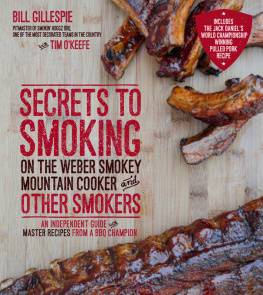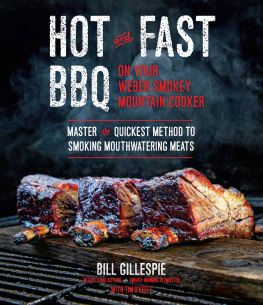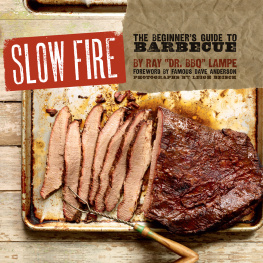Contents
Guide
SECRETS TO SMOKING ON THE WEBER SMOKEY MOUNTAIN COOKER and OTHER SMOKERS
AN INDEPENDENT GUIDE with
MASTER RECIPES FROM A BBQ CHAMPION
BILL GILLESPIE
PITMASTER OF THE SMOKIN HOGGZ BBQ,
ONE OF THE MOST DECORATED TEAMS IN THE COUNTRY
with TIM OKEEFE

The author and publisher have provided this e-book to you for your personal use only. You may not make this e-book publicly available in any way. Copyright infringement is against the law. If you believe the copy of this e-book you are reading infringes on the authors copyright, please notify the publisher at: http://us.macmillanusa.com/piracy.
TO MY WIFE, SHAUNE
From the very beginning you believed in me, you have supported me in everything I do, given me encouragement when I fail and have had this ability to always keep me thinking positive.
For this, I dedicate my first book to you in appreciation of everything you do for me.
You are my rock!!!! I love you.


If this book caught your attention, then chances are youre a barbecue enthusiast who wants to learn more about backyard cooking. When it comes to backyard cooking, the Weber Smokey Mountain Cooker (WSM) is among the best bang-for-your-buck cookers in todays world of barbecue. It is fairly simple to use, and you can obtain incredible results right away. With some knowledge and a little practice, youll learn how to cook authentic barbecue reliably and repeatedly. Sound good? Great, because I am going to help you become a real pro at using the WSM!
What makes me think I can help you become a pro? Well, since 2008, my team Smokin Hoggz has been active on the competition barbecue circuit. Initially, we had some good days, but we also had a few bad ones. Due to our willingness to learn from past mistakes, we got better at what we did, and things eventually became second nature to us. In fact, we were able to obtain high-quality cooking results time and time again. In 2011, our cooking techniques fueled a winning streak that we rode all the way to the Jack Daniels World Championshipthe most prestigious title in competition barbecue!
Shawn, Alan and I are not chefs by training or profession, and we like to think of ourselves as just regular people who love to cook in the backyard. We got started in competition barbecue cooking on a WSM, and now were going to share a lot of the tips, tricks and techniques weve learned along the way. If we could learn to cook great food on the WSM, then we think you can too!
The Weber Smokey Mountain Cooker is one of the most versatile outdoor cookers on the market today. Its price point makes it accessible to most backyard enthusiasts, and its versatility makes it an outstanding value for the money. This single piece of cooking equipment allows you to use various backyard-cooking methods, including low and slow, hot and fast, a combination of both and standard grilling. This book contains 100 recipes to help you become familiar with every aspect of cooking on the WSM. Pretty soon youll be tweaking these recipes to your own liking, and believe us, it wont be long before youre creating entire recipes on your own. Are you ready to get started?
 We recommend keeping a cooking logbook. Any standard notebook will do. The important thing is to notate overall weather conditions, temperature, length of cook time, any tweaks you made to the recipe or cooking process and the end results of the finished product. Maintaining such a log will help you become a better cook, who can more accurately estimate how long it will take to complete the recipes you create.
We recommend keeping a cooking logbook. Any standard notebook will do. The important thing is to notate overall weather conditions, temperature, length of cook time, any tweaks you made to the recipe or cooking process and the end results of the finished product. Maintaining such a log will help you become a better cook, who can more accurately estimate how long it will take to complete the recipes you create.
A FEW WORDS ABOUT TRADITIONAL BARBECUE
The world of barbecue sure is an interesting place. You could even say that it has its own unique culture. Unsurprisingly, barbecue culture contains oral history, lore, lots of sayings and various traditions. While the history of barbecue frequently sparks debate, something that is almost universally agreed upon is a basic definition. And that basic definition describes barbecue as using wood or charcoal to cook meat over a low-heat source for a long period of time. This definition gives rise to the expression low and slow.
Another common agreement in barbecue pertains to the basic flavor profile. In traditional barbecue, the basic flavor profile consists of a spice rub applied to the meat prior to cooking, a smoke flavor that slowly seeps into the meat during the long cook time and a sauce that is layered on the meat during the final stages of the cooking process.
Well, thats pretty much where the agreements end. If you dont already know, then youll quickly learn that the world of barbecue seems to have more debates than agreements. Take sauce, for instance. While sauce typically comprises part of the basic flavor profile, some regions of the country dont use sauce. Yet, even among the regions that do use sauce, you wont find continuity of flavor. Sauce preference in the flavor profile tends to be regional. Some regions prefer a sweet, sticky sauce, while other regions serve a hot, peppery sauce and there are also places that savor a pungent, vinegar-based sauce. Most regions claim that what they serve is the real version of barbecue. With all the debate about who is right and which way is best, discussing barbecue can become as heated as some Thanksgiving family gatherings. Fun, eh? Welcome to the world of barbecue!
SMOKE WOODS, CHIPS AND CHUNKS
In traditional barbecue, a primary component of the basic flavor profile is wood smoke. In essence, wood smoke is just another cooking ingredient that adds flavor to the meat. If you use too much smoke, the food can taste bitter. Yet, if you use too little, the food may be missing just a little something and fall flat. In addition to learning how much wood smoke to use while cooking, youll also need to learn how to pair different types of wood with various meats and seafood.
Dont worry too much though, because we wont make you conduct extensive experimentation in order to determine which wood goes with what meat. Here is a basic list of the characteristics and uses for different woods that are commonplace on the competition circuit. Remember: Your personal preferences should always be the primary factor in determining the wood that you use.
| WOOD | DESCRIPTION |
| Alder | Alder is a mild wood from the Pacific Northwest thats good to use with seafood, poultry, pork and light meat game. |
| Sugar Maple | Frequently found in the Northeast and a staple on the competition scene. Its smoky and mellow. Try mixing with one or two pieces of fruitwood for interesting flavor combinations. Works well with poultry, pork and cheese. |
| Hickory | |
















 We recommend keeping a cooking logbook. Any standard notebook will do. The important thing is to notate overall weather conditions, temperature, length of cook time, any tweaks you made to the recipe or cooking process and the end results of the finished product. Maintaining such a log will help you become a better cook, who can more accurately estimate how long it will take to complete the recipes you create.
We recommend keeping a cooking logbook. Any standard notebook will do. The important thing is to notate overall weather conditions, temperature, length of cook time, any tweaks you made to the recipe or cooking process and the end results of the finished product. Maintaining such a log will help you become a better cook, who can more accurately estimate how long it will take to complete the recipes you create.